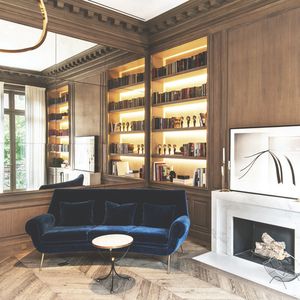French Connection: Conversation with Nathan Litera
What makes a residential space timeless? Is it the use of authentic, durable materials? The tension between old and new? A healthy respect for the rules of classicalism? Or is it something more mysterious and undefined — a je ne sais quoi quality, as the French might say?

Nathan Litera
For Paris-based architect Nathan Litera, the question is layered with complexity, not easily summed up with a pat answer. He might say it’s “un peu de tout” — finding the right juxtaposition of old and new, balancing proportion and light, and a European reverence for craftsmanship, detail and history. His spaces can feel like time travel, as if you’re slipping into a new version of the past suddenly altered by a modern presence. A Belgian castle that artfully casts contemporary art and furnishings against vintage pieces and original architectural elements. A Madison Avenue townhouse that chameleons from Deco to classic to modern. For the recent upgrade of Spring Place restaurant in New York, Litera treated patrons to his fresh vision of 1970s glamour and the midcentury modern movement with patinated brass and bronze mixed with marble, velvets and lush tropical greenery. His new furniture line, Altana, follows a similar modernist-meets-classical track. “A space must be evocative of a story and enable the imagination to be stimulated,” he says.
Spring Place New York
His design storytelling abilities shouldn’t surprise anyone — after all, he trained under Pritzker-winning architect Jean Nouvel, who is known for creating buildings with a visual landscape that fit their context and sometimes by making them contrast with their surroundings. Prior to starting his namesake firm in 2014 with his wife, Lyatt Samama, Litera worked with everyone from Kohn Pedersen Fox in New York to Nouvel and Joseph Dirand in Paris. Their influences continue to define his work to this day, along with his world travels. Although Litera was born in Paris, he was raised in the West Indies and spent his formative years traveling with his family throughout Europe, the U.S. and the Middle East. With his star rising in the U.S. and globally, Homes & Estates was honored to catch up with him to find out what he’s working on next.Coldwell Banker Global LuxuryDo you have any interesting projects in the works right now that you can share with us?
Nathan LiteraWe recently completed Spring Place New York restaurant [which opened in August 2020]. I am now working on several U.S. and French projects. I am especially focused on opening a future showroom where our foreign and domestic clients can visit us and see even better the extent of what we can propose. Lastly, I have just launched a furniture collection inspired by Venetian architecture, Altana, which will be presented in November in New York.

Altana
Coldwell Banker Global LuxuryDescribe your approach to achieving balance in a space.
Nathan LiteraI have been educated as an architect, so proportions and a perspective on symmetry are keys to elaborate a coherent space. Then, the furniture items, whether I design or source them, give a human dimension to the project. I always to try to delve into the context, whether the project is in the U.S., the Middle East or Western Europe. Also, depending on whether it’s residential, hospitality or commercial, the research will be different.
Coldwell Banker Global LuxuryWhat inspires you as a designer?
Nathan LiteraA lot of ideas come to me when I travel in cities with a heritage, especially in Europe, whether it’s seeing a façade, a balcony or a wall finish. Formal architecture codes are an endless source for interior design thinking.

Coldwell Banker Global LuxuryHave your inspirations changed on account of COVID-19 travel restrictions?
Nathan LiteraRight now, I’m drawing inspiration from vintage movies, classical literature and music that are disconnected from current affairs. I am drawn to them for their grace and timeless elegance.
Coldwell Banker Global LuxuryHow much do you look to the past for inspiration?
Nathan LiteraI am quite attracted to traditional references, especially French and Italian ones, while being inspired by modern creation, whether in fashion or dance.

Coldwell Banker Global LuxuryYou’ve described your architecture as “French- and Italian-inspired.” Can you speak a bit to your appreciation for French and Italian design and craftsmanship?
Nathan LiteraYes, it is the core of my work. As I am French, I now tend to express myself more with Italian architecture references, which are more colorful and daring than the classical French architecture. All my fundamental guidelines are French, but I feel I have allowed myself to soar more with Italian codes, materials, finishes. [Italian design] is more opulent and combines very well with modern furnishings and lightings.

Coldwell Banker Global LuxuryHow would you say your West Indies upbringing influences your design?
Nathan LiteraI have been very fortunate to be raised in such a natural environment with its own culture. Surf has been key in my relationship to space and balance. In the West Indies, architecture is very simple with natural materials, so when I moved to Paris, everything had a huge impact and was striking to me.

Coldwell Banker Global LuxuryWhen you look at your design portfolio, which residential project are you most proud of? What lesson did it teach you?
Nathan LiteraI am not proud of just one in particular, but I have a special relationship with the Belgian chateau I recently renovated. Architecture, design, art and the heritage of a foreign country were involved. It was an honor for me to work on this project and to hear that the clients felt so satisfied, living there every day.
Coldwell Banker Global LuxuryWhat was it like to work with Jean Nouvel?
Nathan LiteraIt was one of my early experiences. Jean Nouvel is impressive, as he designs every new project without any preconceived idea or routine. He is constantly redefining his signature style from one project to another. I admire his taking this renewed risk.
Coldwell Banker Global LuxuryFrom your point of view, what makes a home luxurious?
Nathan LiteraObviously, it is a question of space and natural light with coherent proportions. More specifically, the use of certain materials and finishes, the level of craftsmanship that reflect traditions, whether it is for floors, fabrics, hardware or decorative painting.
By Alyson Pitarre This article originally appeared in Homes & Estates magazine.
SHARE





